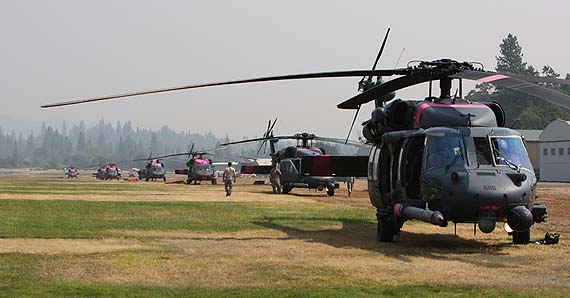
(Update: the two C-130J Modular Airborne FireFighting Systems (MAFFS) air tankers at the 146th Airlift Wing at Channel Islands California, MAFFS #4 and #6, are also being activated today. Initially they will be working out of McClellan Air Field near Sacramento. Two MAFFS from Cheyenne, Wyoming were activated a week or two ago and have mostly been based at Boise, Idaho.)
With several large wildfires burning in northern and central California, the Governor’s Office of Emergency Services has tasked the California National Guard (CNG) to activate helicopter units to assist local, state and federal fire agencies.
The helicopters are a combination of 14 UH-60 Black Hawk and CH-47 Chinook helicopters and three LUH-72 Lakota helicopters. The crews and assets from the California Army National Guard were activated under the direction of Adjutant General Maj. Gen. David S. Baldwin at the request of Cal OES on behalf of the California Department of Forestry and Fire Protection (CAL FIRE).
The CNG helicopters and crews, which were deployed from around the state, will launch from Mather Army Aviation Support Facility and other locations to support CAL FIRE in battling wildfires across Northern California. The Black Hawks and Chinooks are equipped respectively with 660-gallon and 2000-gallon water buckets to fight the flames. The Black Hawks also are capable of functioning in a medevac capacity as well, with an onboard hoist for extracting injured personnel from rugged terrain. The Lakota will serve as an observation platform, capable of streaming near real-time video and thermal imagery of the fires to incident commanders on the ground.
The CNG helicopter crews will be working in coordination with the CAL FIRE and local firefighting crews in accordance with the Statewide Mutual Aid System that cuts across military, state and regional levels.

The military fire aircraft are not the first line of defense in fire operations, for several reasons, but I’m quite happy to work with them over the fire. I’ve seen more dragged buckets from military helicopters, but it’s not their primary mission, and when they’re called to duty, it’s because they’re needed.
I have no sense of competition with the MAFFS units. They do their job, I do mine. I don’t decide where to fight fire; I get dispatched. The government makes those calls. MAFFS does not have all the capabilities of commercial tanker operations, nor the depth nor breadth of experience. They need leads. They require a large footprint in operations, and they do sometimes pull out of fires or from being attached to a fire. Those are limitations, to some degree in their use.
MAFFS also offers a valuable resource in personnel and aircraft over fires when needed, and despite the fact that some might consider them “competition,” I submit that we’re fortunate to have that option. They may not be full time firefighters, but at the time they’re activated and brought into the fold, they’re a part of the firefighting community, and another of the proverbial “tools in the toolbox.” Let’s not alienate them when they’re contributing their time, their equipment, and facing the same threats we all face in the fire environment. We’re all on the same team.
Don’t know what side air attack you are on
But in both the Blackhawk world and military C130 world you are going to get varying levels of experience and varying levels of personnel attached as support from Guard , Reserve, or Active unit
By being ” RETIRED” one would have thought being an air attack this little known facts would have been known by now……
Where is that mentoring program in the world of the land management agencies when the DoD mission is defense
Might get lucky to find 5- 10 K hour Hawk pilots nowadays but I seriously am doubting that with retirements and lower time pilots with 700 to 4K range. Don’t expect much….
Like u say. Guv incapable……..but ain’ t many a civilians owning Blackhawks engaging in much other than LACO Fire and the buoyyyzz with the S70 Firehawk
Tough when your aircraft are doing DoD work and then get called to fight fire.
Maybe ought to be damned happy you get what u get…
Agreed. I was recently in Boise and saw nearly thirty people in fatigues hanging around the pits to man 2 C-130’s. I never knew we were so efficient at doing the same job with only 3 men per aircraft. I wonder why costs have gone ballistic?
In the FUSA this used to be illegal. But it is no longer, we were transformed.
As an air attack I sent quite a few Blackhawks RTB before they ever engaged in operations other than arriving, unfamiliarity with equipment and lack of experience were rampant. You cannot send a rookie into an active fire zone as PIC, there is an obvious need for a mentoring program above and beyond what currently exists. Government is incapable of responding efficiently.
Just another government agency competing with private aerial fire fighting companies. How would you like to compete with local, state and federal government.